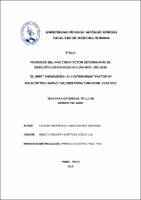Mostrar el registro sencillo del ítem
Fenómeno del niño factor determinante de desnutrición en niños de Cura Mori, año 2019
| dc.contributor.advisor | Martínez Uceda, Luz | |
| dc.contributor.author | Talledo Hernández, Marleny del Socorro | |
| dc.creator | Talledo Hernández, Marleny del Socorro | |
| dc.date.accessioned | 2019-05-06T15:20:35Z | |
| dc.date.available | 2019-05-06T15:20:35Z | |
| dc.date.issued | 2019 | |
| dc.identifier.uri | https://hdl.handle.net/20.500.12759/4755 | |
| dc.description.abstract | OBJETIVO: Determinar el impacto que generó el Fenómeno El Niño en los índices de anemia y desnutrición en menores de 6 a 11 años del Distrito de Cura Mori. MATERIALES Y METODOS: Estudio observacional, histórico – prospectivo, transversal y comparativo con 204 niños (as) el distrito de Cura Mori que cuentan con SIS. Para el análisis se utilizó una base de datos en Excel y se realizó el análisis estadístico en programa SPSS 22.3. RESULTADOS: En el año de ocurrencia del Fenómeno de El Niño (FEN) el 14,7% de los infantes tenían algún tipo de anemia, dos años después el 32,9% de estos mismos niños tienen algún tipo de anemia. La desnutrición crónica en pleno FEN fue de 20.1%, dos años después aumento el porcentaje a 30.5% en estos mismo infantes. CONCLUSION: El promedio de hemoglobina en niñas al inicio del FEN fue de 12.5 mg% y en niños 12.5 mg%. En el año 2019 el promedio de hemoglobina disminuyo al 12.16mg% y 11.89mg% respectivamente. La desnutrición crónica en el FEN en comparación al año 2019 aumento de un 20.1% a 30.5% respectivamente. | es_PE |
| dc.description.abstract | OBJECTIVE: To determine the impact generated by the “El Nino” phenomenon on anemia and malnutrition indexes that affect Cura Mori children between the ages of 6 and 11. MATERIALS AND METHODS: Observational study, historic - prospective, transversal and comparative with 204 children from the district of Cura Mori that do have access to health care subsidized by the government. Such analysis was done using a database in Excel and and statistic analysis was performed. Program SPSS 22.3 RESULTS: During the year “El Nino” phenomenon hit, 14.7% of the infants had some kind of anemia. Two years later, 32.9% have some kind of anemia as well. The chronic malnutrition during the phenomenon was 20.1%, two years later the percentage increased to 30.5% within the same children universe. CONCLUSION: The average hemoglobin levels within girls at the beginning of the phenomenon was 12.5% mg% and 12.5% within boys. During the year of 2019, the hemoglobin levels dropped to 12.16mg% and 11.89mg% respectively. The chronic malnutrition during the phenomenon compared to 2019 raised from 20.1% to 30.5% respectively. | en_US |
| dc.description.uri | Tesis | es_PE |
| dc.format | application/pdf | es_PE |
| dc.language.iso | spa | es_PE |
| dc.publisher | Universidad Privada Antenor Orrego - UPAO | es_PE |
| dc.relation.ispartofseries | T_MEDP_101 | |
| dc.rights | info:eu-repo/semantics/openAccess | es_PE |
| dc.source | Universidad Privada Antenor Orrego | es_PE |
| dc.source | Repositorio Institucional - UPAO | es_PE |
| dc.subject | Desnutrición crónica | es_PE |
| dc.subject | Anemia | es_PE |
| dc.subject | Fenómeno del niño | es_PE |
| dc.title | Fenómeno del niño factor determinante de desnutrición en niños de Cura Mori, año 2019 | es_PE |
| dc.type | info:eu-repo/semantics/bachelorThesis | es_PE |
| thesis.degree.level | Título Profesional | es_PE |
| thesis.degree.grantor | Universidad Privada Antenor Orrego. Facultad de Medicina Humana | es_PE |
| thesis.degree.name | Médico cirujano | es_PE |
| thesis.degree.discipline | Medicina Humana | es_PE |
Ficheros en el ítem
Este ítem aparece en la(s) siguiente(s) colección(es)
-
Medicina Humana [2739]

